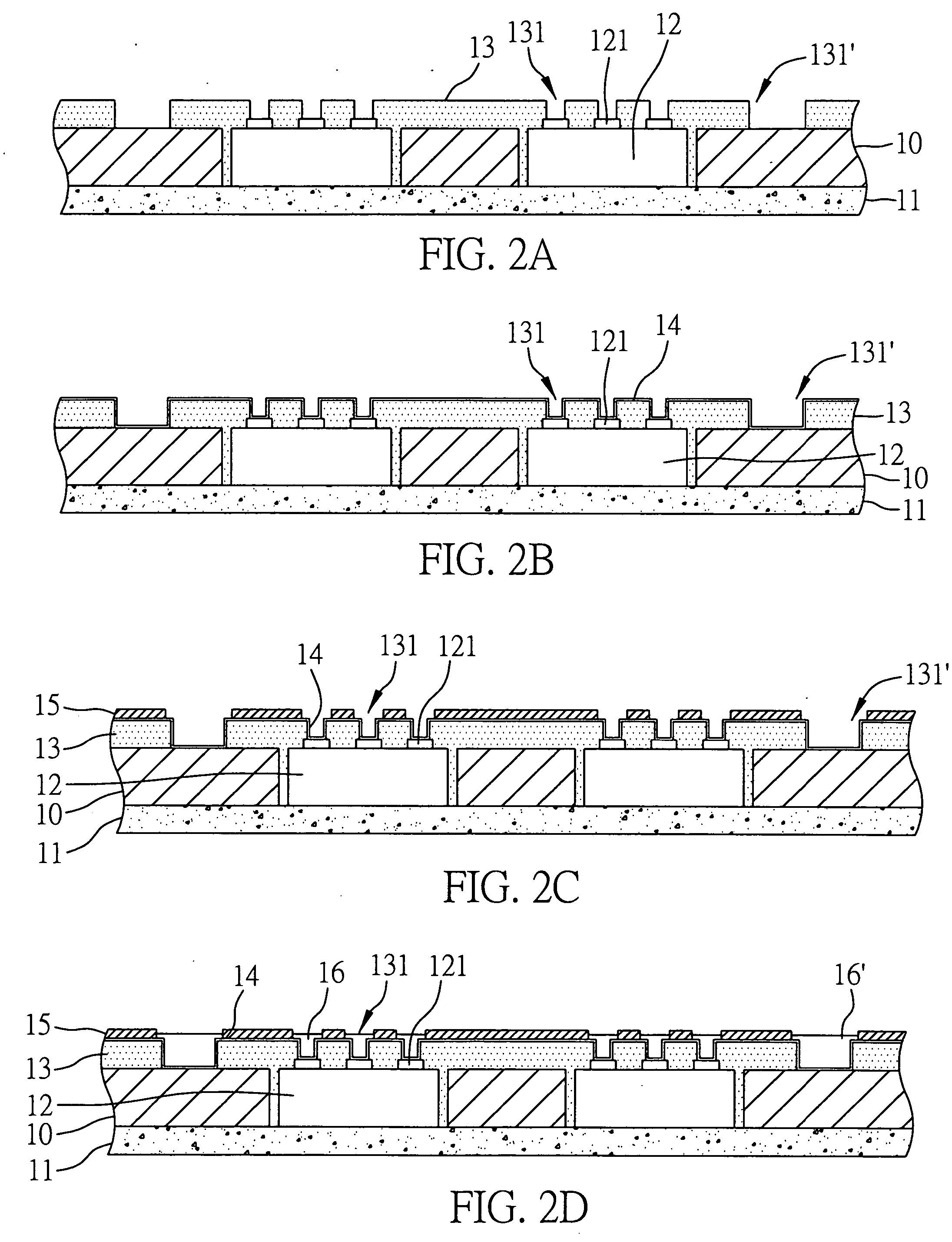Method for fabricating carrier structure integrated with semiconductor element
a carrier structure and semiconductor technology, applied in the field of carrier structure integration of semiconductor elements, can solve the problems of complex fabrication process, increased overall height of the package, and inability to facilitate size miniaturization, so as to simplify the overall fabrication process and reduce the fabrication cost
- Summary
- Abstract
- Description
- Claims
- Application Information
AI Technical Summary
Benefits of technology
Problems solved by technology
Method used
Image
Examples
first preferred embodiment
[0020]FIGS. 1A to 1E are cross-sectional schematic diagrams showing procedural steps of the method for fabricating a carrier structure integrated with a semiconductor element according to a first preferred embodiment of the present invention.
[0021] Referring first to FIG. 1A, a carrier 10 is provided, which can be an insulating board, printed circuit board, laminated substrate, or build-up substrate, etc.
[0022] Referring to FIG. 1B, the carrier 10 is formed with at least one opening 101 therein.
[0023] Referring to FIG. 1C, then a supporting substrate 11 is attached to a lower surface of the carrier 10 to temporarily seal the bottom of the opening 101. The supporting substrate 11 can be a film, dry film, tape, metal board, or insulating board, etc.
[0024] Referring to FIG. 1D, at least one semiconductor element 12 is embedded in the opening 101 of the carrier 10. The semiconductor element 12 can be a chip or a chip-type passive component with a plurality of electrode pads 121 form...
second preferred embodiment
[0029]FIGS. 2A to 2F are cross-sectional schematic diagrams showing procedural steps of the method for fabricating a carrier structure integrated with a semiconductor element according to a second preferred embodiment of the present invention. In this second embodiment, the foregoing steps of FIGS. 1A to 1E are repeated and not to be further described here, which are followed by the steps shown in FIGS. 2A to 2F.
[0030] Referring to FIG. 2A, after the photosensitive insulating layer 13 is formed over the surface of the carrier 10 by coating or pressing (as shown in FIG. 1E), a patterning process is performed on the photosensitive insulating layer 13, such that recessed grooves 131, 131′ are formed in the photosensitive insulating layer 13, and electrode pads 121 of the semiconductor element 12 and predetermined portions on the surface of the carrier 10 are exposed via the recessed grooves 131, 131′ respectively. The recessed grooves 131, 131′ can be contact holes or circuit slots. T...
PUM
| Property | Measurement | Unit |
|---|---|---|
| photosensitive | aaaaa | aaaaa |
| conductive | aaaaa | aaaaa |
| height | aaaaa | aaaaa |
Abstract
Description
Claims
Application Information
 Login to View More
Login to View More - R&D
- Intellectual Property
- Life Sciences
- Materials
- Tech Scout
- Unparalleled Data Quality
- Higher Quality Content
- 60% Fewer Hallucinations
Browse by: Latest US Patents, China's latest patents, Technical Efficacy Thesaurus, Application Domain, Technology Topic, Popular Technical Reports.
© 2025 PatSnap. All rights reserved.Legal|Privacy policy|Modern Slavery Act Transparency Statement|Sitemap|About US| Contact US: help@patsnap.com



